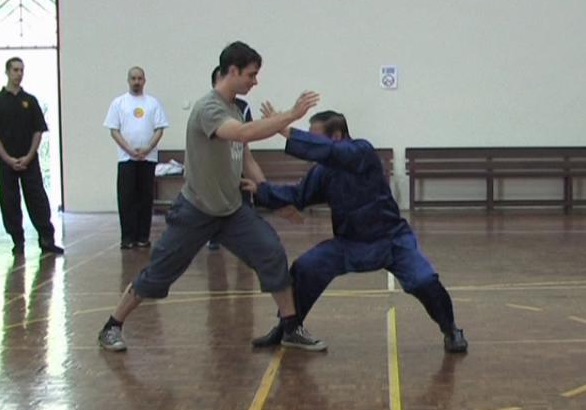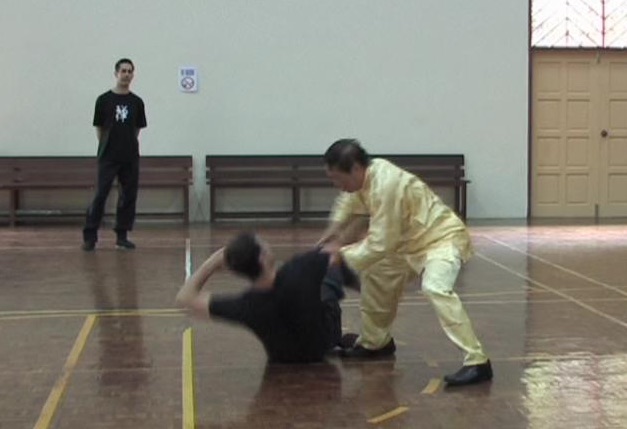APPLYING CONSOLIDATED FORCE OR FLOWING FORCE ACCORDING TO DIFFERENT SITUATIONS

Consolidated force is used when striking an opponent
Question 10
From past experience of crossing hands with some of my seniors within our school, I have had the privilege to receive some glimpses of differing manifestations of force:
- a sensation of 'prickly needles' entering the body
- electric burning entering the body
- an impenetrable tube with a core of iron that cannot be properly grasped by the hand, i.e. the hand does not feel it has made contact with the other exponent's skin
- the exterior feels physical and muscular, but deep inside there is something solid and impenetrable
- something 'alive' (without mercy) that is being held tightly on a leash, ready to attack if released
- solid, soft, gentle, absorbing in a way that drains one's power and stamina
Which of the two categories of 'consolidated' and 'flowing' force do these descriptions fall under?
Why are there so many varying manifestations of force?
Which is better to use to manage the above manifestations, consolidated or flowing force?
Sifu Emiko
Answer
Classifying force as consolidated and flowing is for convenience. Sometimes there is overlapping, sometimes it is not clear-cut which classification a particular manifestation belongs, or the same manifestation may be classified differently in different situations. Nevertheless, the following manifestations may be classified as follows:
- sensation of 'prickly needles' entering the body -- flowing force.
- electric burning entering the body – flowing force.
- an impenetrable tube with a core of iron that cannot be properly grasped by the hand, i.e. the hand does not feel it has made contact with the other exponent's skin – consolidated force.
- the exterior feels physical and muscular, but deep inside there is something solid and impenetrable – consolidated force.
- something 'alive' (without mercy) that is being held tightly on a leash, ready to attack if released – flowing force.
- solid, soft, gentle, absorbing in a way that drains one's power and stamina – flowing force.
Because there are many different situations and conditions, there are many varying manifestations of force. When a situation or condition changes, the manifestation may also change.
For example, a sensation of “pricking needles” entering the body is described as flowing force. When we lower our arms in Lifting the Sky, we may have this sensation. As we continue performing Lifting the Sky, the flowing force and pricking sensation increase.
But if we stop the movement and let the arms hang down leisurely, the flowing force may turn into consolidated force, while the pricking sensation may continue for some time. If we stay at this static position long enough, the consolidated force accumulates, and the pricking sensations may change into something solid.
In the second example above, electric burning entering the body during crossing hands is classified as flowing force. The force of your sparring partner flowed into you. But if he focuses his force to consolidate it, the burning electricity may become an impenetrable tube with a core of iron.
We can use consolidated force or flowing force to manage the above manifestations. The choice depends on our ability, i.e. whether we are better in applying consolidated force or flowing force, or it depends on the situation. i.e. whether consolidated force or flowing force will overcome the situation more effectively.
When a sensation of prickly needles of an opponent flows into you during crossing hands, you can force him back using consolidated force, or fell him onto the ground using flowing force.
When the flowing force of electric burning of an opponent enters your body, you can strike back using consolidated force, or you can deflect his attack using flowing force. In this case, unless you are overwhelming more powerful than your opponent, it is better to use flowing force, as striking back with consolidated force may not stop his flowing electric force enter you.
Instead of grasping or gripping him, you can strike his arm which is like an impenetrable tube with a core of iron if your force is stronger. If your opponent is stronger, you can lead his arm to futility using flowing force.
You may use consolidated force to break both the muscular exterior as well as the solid interior of your opponent if you are more powerful. Or you can use your flowing force to penetrate his exterior and interior hardness, like electricity penetrating a bell. Otherwise use flowing force to lead his attack to futility.
Against something being held on a leash, striking it with consolidated force is recommended. However, if your consolidated force is inadequate, you need to escape using flowing force.
Use consolidated force to intercept an opponent’s solid yet gentle way, and break its flow. If you use flowing force, you have to first flow with the opponent, then turn the momentum back on him.
The examples show that consolidated force is recommended when you are stronger. If the opponent is stronger, flowing force can neutralize him and then counter attack.

Flowing force is used when felling an opponent onto the ground
The questions and answers are reproduced from the thread Secrets of Building Internal Force in the Shaolin Wahnam Discussion Forum.
LINKS
